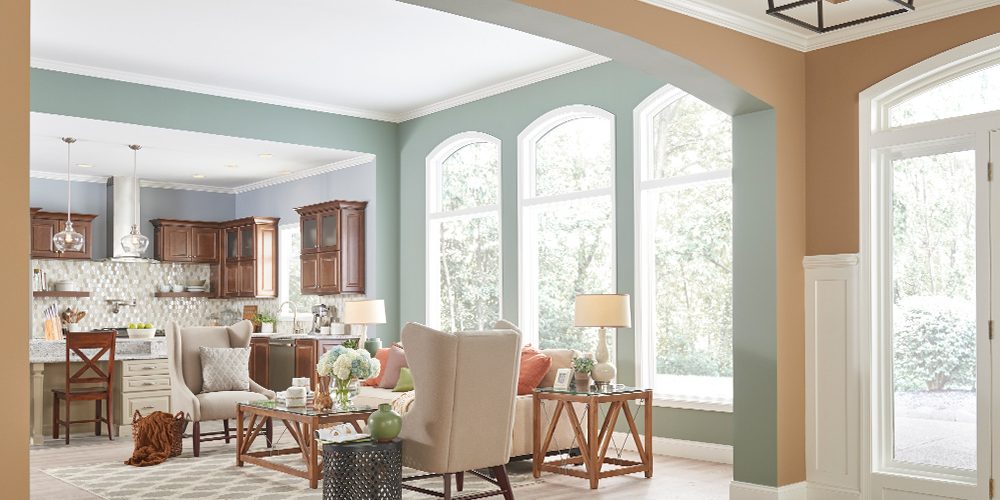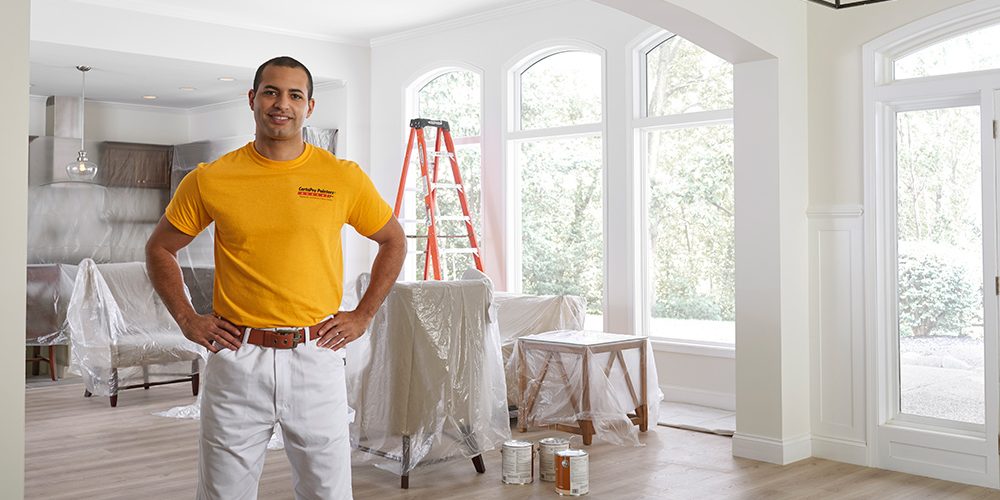
What Does Interior Painting in Toronto Cost?
Posted on January 4, 2021
Planning on doing some interior painting in Toronto this year? As one of the most cost-effective means of enhancing the enjoyment and value of your home, painting is always a smart investment. Of course, it makes sense to understand the basic factors that impact the price of interior painting, so you have some idea of what to expect based on your project specifics.
As with many home services, the time involved – which translates to labour cost for the interior painters – is generally the largest cost component of a paint job, with product costs (primer/paint as well as caulking/wood filler, and masking materials) making up a smaller portion of the cost. With this in mind, below we’ve listed the three main factors which determine the cost of interior painting in Toronto.

What are you painting?
People choose to paint a wide variety of surfaces within a home, from the obvious ceilings and walls, through windows, doors, casings, baseboards, and crown molding, to elements such as stair risers and stringers, railings and spindles, as well as custom items such as mantles and bookcases.
In each case, the amount of time required to properly prepare and paint the surface will vary primarily according to its design. For example, much of a ceiling or wall surface can be time-efficiently painted using a paint roller with only minor supporting brushwork, whereas ornate crown moulding would require slower and more detailed brushwork. Similarly, multi-pane windows and doors take longer to prepare and paint than simpler designs.
Another consideration can be painter accessibility, which means that areas such as vaulted ceilings, and stairwells in open-concept homes can take extra time to safely prepare and paint. In some cases, specialized equipment or the support of additional interior painters may also be required to complete the work.
What is the condition of the surfaces to be painted?
As implied above, preparation is key to any proper paint job – and this takes time, often as much or more time than painting the surface. Paint will not mask surface imperfections, so prepping the surfaces properly prior to painting makes all the difference in producing a high-quality result. Here are some generalized examples for illustration:
New – in the case of new construction or renovations where unpainted drywall and/or trim is installed, ceilings and walls will require a coat of drywall primer prior to painting. New trim such as door frames and baseboards generally require time-consuming filling of all joints/gaps and nail holes prior to sanding smooth for priming and then painting.
Good condition – ceilings generally unmarked; walls may have some nail holes and minor nicks in higher-traffic areas; trim such as door frames and baseboards have minor imperfections.
Fair condition – ceilings may have minor hairline cracks, walls may have greater levels of damage such as larger dents or small holes; trim may be dinged up and in need of additional dent-filling and sanding prior to painting.
Poor condition – ceilings may be badly cracked, or perhaps damaged from a previous water leak (necessitating more extensive repairs); walls may have significant plaster or drywall damage; trim may require significant patching and smoothing, or localized replacement.

What new colours are being selected as compared to the current colours?
The third most common determinant of the price of an interior paint job has to do with wall colour – specifically, what the new colour will be relative to the current colour. When changing from a very dark colour to a very light one (or vice versa), additional coats of paint may be required to fully hide the current paint coat, and accurately bring out the colour of the new paint. Certain very bright colours can also require additional coats. While the customer’s decision as to whether to apply additional coats must take place while viewing the work in progress, it can be helpful to bear this colours-and-coats consideration in mind when contemplating significant colour changes.
Special situations:
Although there is a wide range of potential special cases regarding the cost of interior painting in Toronto, several common issues stand out:
Wallpaper/wallcovering removal – although seemingly straightforward, removing wallpaper or other wallcovering material can take a surprising amount of time, depending upon how readily the material can be removed from the wall. If the adhesive allows for easy removal, and little to no residue is left on the wall, a light scuff sanding is all that is required prior to priming/painting. However, if the adhesive is more aggressive, time-consuming scraping of the affected areas may be required to ensure all the adhesive has been removed prior to sanding. If it the adhesive is particularly aggressive, some of the wall surfaces may come off with the material, necessitating a depression-filling skim coat prior to sanding and coating application.
Repairs of significant cracks or previous water damage – in cases where ceilings or walls display damage from issues such as foundation settling cracks or a previous water leak, the extent of the substrate damage can be difficult to determine before work commences. In the case of water-damaged drywall, areas adjacent to the specific site of the issue may also require repair or replacement. In the case of older homes with plaster ceilings and walls, producing a smooth surface and lasting result may similarly require more extensive repairs of the surrounding areas.
Smoke or oil stains – smoke and oil stains present adhesion and stain/odour-blocking challenges for typical latex paints. Special primers (e.g. shellac-based) are generally required to effectively address these issues prior to painting, increasing labour and material costs.
Given their inherent variability, special case situations are often quoted on a “time and materials” basis, following review, and discussion with the customer.

What’s the bottom line?
Given the above factors, it can be seen that the project specifics determine final pricing. For the sake of budgetary context however, below are some approximate project prices (assuming good to fair condition):
11’ x 12’ Bedroom (ceiling, walls, closet, window, doors, casings, baseboards): $900
14’ x 16’ Master Bedroom (ceiling, walls, walk-in closet, windows, doors, casings, baseboards): $1,200
18’ x 22’ Family Room (ceiling, crown moulding, walls, doors, windows, casings, baseboards): $ 1,600
Whole-home painting in Toronto can range from about $1,750 for a 1-bedroom condo with den in “like new” condition (walls and baseboards only), to $5,500+ for an older 3-bedroom, 2-story home with furnished basement in good to fair condition (ceilings, walls, doors, casings, baseboards). Larger homes and those with more customized details will vary further from there.
For more detail, please review our Interior Painting Pricing Guide, and call or book online with us for a free, detailed estimate. We would be very pleased to get into the finer details of your project, to help define the best value scope for your budget, and bring your home improvement project to life!





